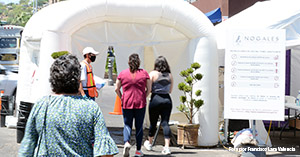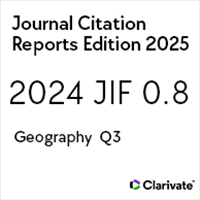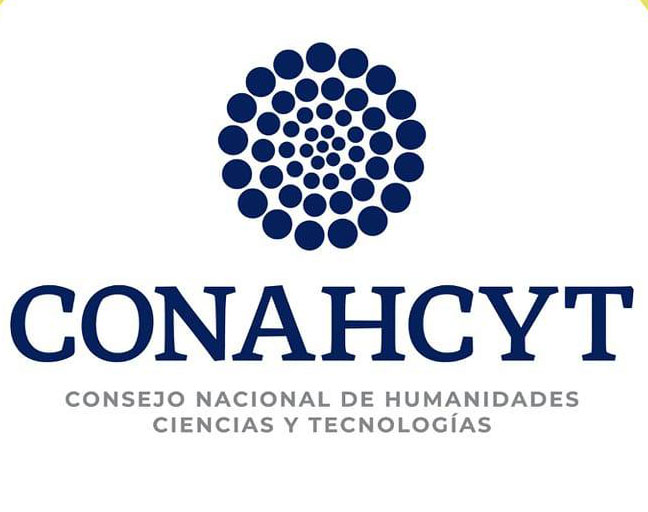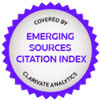Las fronteras de la pandemia: lecciones para la gobernanza y la cooperación en las ciudades de la frontera México-Estados Unidos
The borders of the pandemic: lessons on governance and cooperation in United States-Mexico border cities
https://doi.org/10.21670/ref.2104067
Palabras clave:
COVID-19, gobernanza, cooperación transfronteriza, actores locales, refronterización, fronteraResumen
Este artículo documenta y analiza la respuesta de las ciudades de la región fronteriza México-Estados Unidos a la emergencia sanitaria y a un proceso sustancial de refronterización desencadenado por el COVID-19. Como muchos otros países, la estrategia principal de Estados Unidos y México para contener la propagación del coronavirus ha sido la adopción de medidas de distanciamiento social y restricciones a la movilidad, incluyendo el cierre de la frontera común. Una implicación inmediata de este proceso es el reforzamiento de la presencia de los gobiernos nacionales en la gestión de la salud fronteriza y, potencialmente, la contracción de los espacios de gobernanza en los que participan tradicionalmente actores subnacionales. Mediante el análisis de datos secundarios de ocho pares de ciudades fronterizas contiguas, se examinan las respuestas de actores locales a la pandemia en el marco de un proceso acelerado de refronterización y se perfilan escenarios de gobernanza y cooperación trasfronteriza pospandemia.Abstract This article documents and analyzes the response of cities in the u.s.-Mexico border region to the health emergency and a significant process of rebordering triggered by COVID-19. Like many other countries, the United States and Mexico's primary strategy to contain the spread of coronavirus has been the adoption of social distancing measures and restrictions on mobility, including the closure of the common border. An immediate implication of this process is the strengthening of national governments' presence in border health management and, potentially, the contraction of governance spaces in which subnational actors traditionally participate. By analyzing secondary data for eight pairs of co-adjacent border cities, local actors' responses to the pandemic are examined in the context of a rapid rebordering process and postpandemic governance, and cross-border cooperation scenarios are explored.
Citas
ABC15.com staff. (2020). Nogales mayor asks Gov. Ducey for authority to require city’s residents to wear masks. ABC 15 Arizona. https://www.abc15.com/news/region-central-southern-az/nogales/city-of-nogales-mayor-asking-gov-ducey-for-authority-to-require-masks
Agnew, J. (1994). The territorial trap: the geographical assumptions of international relations theory. Review of International Political Economy, 1(1), 53-80. http://www.jstor.org/stable/4177090
Álvarez, R. (2012). Reconceptualizing the space of the Mexico-U.S. borderline. En T. Wilson & H. Donnan (Eds.), A companion to border studies (pp. 538-556). Blackwell Publishing.
Anderson, J., Gerber, J. & Foster, L. (2008). Fifty years of change on the U.S.-Mexico border: growth, development, and quality of life. University of Texas Press.
Arizona Medical Association. (2020). Stay calm. Stay alert. Responding to the Coronavirus (COVID-19). Resources for physicians & patients. https://www.azmed.org/page/Coronavirus
Arreola, D. D. (2010). The Mexico-US borderlands through two decades. Journal of Cultural Geography, 27(3), 331-351. https://doi.org/10.1080/08873631.2010.517621
Arreola, D. D. & Curtis, J. R. (1993). The Mexican border cities: landscape anatomy and place personality. University of Arizona Press.
azdhs-admin. (2011). Building a healthier border. Arizona Department of Health Services. https://directorsblog.health.azdhs.gov/building-a-healthier-border/
Bureau of Transportation Services (BTS). (2020). Border Crossing/Entry Data. https://www.bts.gov/browse-statistical-products-and-data/border-crossing-data/border-crossingentry-data
California Department of Public Health (CDPH). (2020). COVID-19 Race and ethnicity data https://www.cdph.ca.gov/Programs/CID/DCDC/Pages/COVID-19/Race-Ethnicity.aspx
Center for Disease Control and Prevention (CDC). (2020). Agriculture Workers and Employers Interim Guidance from CDC and the U.S. Department of Labor. https://www.cdc.gov/coronavirus/2019-ncov/community/guidance-agricultural-workers.html
Collins-Dogrul, J. (2006). Managing US-Mexico “border health”: an organizational field approach. Social Science & Medicine, 63(12), 3199-3211. https://doi.org/10.1016/j.socscimed.2006.07.031
Collins-Dogrul, J. (2012). Tertius Iungens brokerage and transnational intersectoral cooperation. Organization Studies, 33(8), 989-1014. https://doi.org/10.1177%2F0170840612445118
Da Silva, C. (2020, 20 de agosto). Trump claims border wall is helping stop spread of COVID-19 from Mexican city in ‘South America’. Newsweek. https://www.newsweek.com/trump-border-wall-coronavirus-south-america-1526434
Detsky, A. S. & Bogoch, I. I. (2020). COVID-19 in Canada: experience and response. JAMA, 324(8), 743-744. doi:10.1001/jama.2020.14033
Department of Homeland Security (DHS). (2020a). Fact Sheet: DHS measures on the border to limit the further spread of Coronavirus. https://www.dhs.gov/news/2020/08/14/fact-sheet-dhs-measures-border-limit-further-spread-coronavirus
Department of Homeland Security (DHS). (2020b). Nationwide enforcement encounters: Title 8 Enforcement actions and Title 42 expulsions. https://www.cbp.gov/newsroom/stats/cbp-enforcement-statistics/title-8-and-title-42-statistics
Department of Homeland Security (DHS). (2020c). USBP & ICE Ramping up repatriation flights; effort aimed at reducing COVID-19 exposure in U.S. https://www.cbp.gov/newsroom/local-media-release/usbp-ice-ramping-repatriation-flights-effort-aimed-reducing-covid-19
El Colegio de la Frontera Norte (El Colef). (2020a, 16 de junio). Acciones implementadas ante COVID-19 en los estados de la región fronteriza México-Estados Unidos [Video]. YouTube. https://www.youtube.com/watch?v=rZ8rV_zaFdg&ab_channel=ElColegiodelaFronteraNorte-ElColef
El Colegio de la Frontera Norte (El Colef). (2020b). Migrantes en albergues en las ciudades fronterizas del norte de México (Documentos de contingencia 2. Poblaciones vulnerables ante el COVID-19). https://www.colef.mx/wp-content/uploads/2020/04/Albergues_w6.pdf
Embajada y Consulados de Estados Unidos en México. (2020). Como socios, vecinos y amigos, cooperamos en la respuesta ante el COVID19. https://mx.usembassy.gov/es/como-socios-vecinos-y-amigos-cooperamos-en-la-respuesta-ante-el-covid19/
Ganster, P. & Collins, K. (2017). Binational cooperation and twinning: a view from the US–Mexican border, San Diego, California, and Tijuana, Baja California. Journal of Borderlands Studies, 32(4), 497-511. https://doi.org/10.1080/08865655.2016.1198582
García-Pérez, H. (2007). Proyecto de seguimiento a la Asociación Fronteriza Mexicano-Estadounidense de Salud/United States-Mexico Border Health Association (AFMES/USMBHA). http://alamo.colson.edu.mx:8085/sitios/CESS/091020_frutosTrabajo/frutos_archivos/2007_Garcia_ProyectoSeguimiento_AvanceInvest.pdf
García-Pérez, H. (2010). Health issues. North American Center for Transborder Studies-Arizona State University. https://doi.org/10.13140/RG.2.2.26679.85922
Garza-Almanza, V. (2018). Fundación Binacional México-Estados Unidos para la Salud y el Ambiente: Crónica de un proyecto altruista: 1982-1991. Culcyt, 15(65), 8-33. http://erevistas.uacj.mx/ojs/index.php/culcyt/article/view/2661/2461
Gerber, J., Lara-Valencia, F. & de la Parra, C. (2010). Re-Imagining the U.S.-Mexico border: policies toward a more competitive and sustainable transborder region. Global Economy Journal, 10(4). https://doi.org/10.2202/1524-5861.1681
Grimson, A. (2006). Cultures are more hybrid than identifications: A dialogue on borders from the Southern Cone. Latino Studies, 4(1), 96-119. https://doi.org/10.1057/palgrave.lst.8600177
Hataley, T. & Leuprecht, C. (2018). Determinants of cross-border cooperation. Journal of Borderlands Studies, 33(3), 317-328. https://doi.org/10.1080/08865655.2018.1482776
Homedes, N. & Ugalde, A. (2003). Globalization and health at the United States-Mexico border. American Journal of Public Health, 93(12), 2016-2022. https://doi.org/10.2105/AJPH.93.12.2016
Instituto Nacional de Estadística y Geografía (Inegi). (2020). Censo de Población y Vivienda 2020. https://www.inegi.org.mx/datos/#Areas_geograficas
Johnson, M. A. & Niemeyer, E. D. (2008). Ambivalent landscapes: environmental justice in the US–Mexico borderlands. Human Ecology, 36(3), 371-382. https://doi.org/10.1007/s10745-008-9171-8
Kassie, E. & Marcolini, B. (2020). How ICE exported the coronavirus. an investigation reveals how immigration and customs enforcement became a domestic and global spreader of COVID-19. https://www.themarshallproject.org/2020/07/10/how-ice-exported-the-coronavirus
Klatt, M. (2020). What has happened to our cross-border regions? Corona, unfamiliarity, and transnational border activism in the Danish-German border region. En C. Wille & R. Kanesu (Eds.), Bordering in pandemic times: insighths into the COVID-19 lockdown (Borders in perspective 4, pp. 43-47): UniGR-Center for Border Studies. https://ubt.opus.hbz-nrw.de/opus45-ubtr/frontdoor/deliver/index/docId/1428/file/UniGR-CBS_Borders+in+Perspective_thematic+issue_Vol.+4.pdf
KTAR-NEWS. (2020). Ducey to give local leaders authority to institute mandatory mask policy. https://ktar.com/story/3297947/ducey-to-give-local-leaders-authority-to-institute-mandatory-mask-policy/
Lara-Valencia, F., Agulló, J., García-Pérez, H., Trillo, J. M. & Oliveras, X. (2020). COVID-19 and cross-border mobility. An international survey of border experts. Arizona State University. https://doi.org/10.13140/RG.2.2.29353.72807
Lobato, M. N. & Cegielski, J. P. (2001). Preventing and controlling tuberculosis along the U.S.-Mexico border. https://www.cdc.gov/MMWR/Preview/mmwrhtml/rr5001a1.htm
National Public Radio (NPR). (2020). Lessons in handling the coronavirus Arizona could learn from Massachusetts. https://www.npr.org/2020/07/06/887925743/lessons-in-handling-the-coronavirus-arizona-could-learn-from-massachusetts
Organización Internacional para las Migraciones (OIM). (2020a). Migrantes en alojamientos temporales en el norte de México reciben supervisión médica constante. https://rosanjose.iom.int/site/es/noticia/migrantes-en-alojamientos-temporales-en-el-norte-de-mexico-reciben-supervision-medica
Organización Internacional para las Migraciones (OIM). (2020b). OIM y socios ofrecen alojamiento digno en ‘hotel filtro’ para migrantes que necesitan pasar la cuarentena en el norte de México. https://rosanjose.iom.int/site/es/noticia/oim-y-socios-ofrecen-alojamiento-digno-en-hotel-filtro-para-migrantes-que-necesitan-pasar-la
Panamerican Health Organization (Paho). (2012). United States-Mexico border area. https://www.paho.org/salud-en-las-americas-2012/index.php?option=com_content&view=article&id=63:united-statesmexico-border-area&Itemid=173&lang=en
Prendergast, C. (2020, 8 de mayo). Desinfectan con aerosol a quienes cruzan en carro de Arizona a Nogales, Sonora. La Estrella de Tucson. https://tucson.com/laestrella/frontera/desinfectan-con-aerosol-a-quienes-cruzan-en-carro-de-arizona-a-nogales-sonora/article_e36a50c0-914b-11ea-95f0-bb2df2906697.html
Rosales, C., Carvajal, S. & De Zapien, J. (2016). Emergent public health issues in the US-Mexico border region. Frontiers Media. https://www.frontiersin.org/research-topics/3003/emergent-public-health-issues-in-the-us-mexico-border-region
Schneider, E., Laserson, K. F., Wells, C. D. & Moore, M. (2004). Tuberculosis along the United States-Mexico border, 1993-2001. Revista Panamericana de Salud Pública, 16(1), 23-34. https://scielosp.org/pdf/rpsp/2004.v16n1/23-34/en
Shear, M. D. & Dickerson, C. (2020, 10 de agosto). Trump considers banning re-entry by citizens who may have coronavirus. The New York Times. https://www.nytimes.com/2020/08/10/us/politics/trump-coronavirus-border.html
Sohn, C. (2014). The border as a resource in the global urban space: a contribution to the cross-border metropolis hypothesis. International Journal of Urban and Regional Research, 38(5), 1697-1711. https://doi.org/10.1111/1468-2427.12071
TransborderLab. (2020). Effects of the COVID-19 Pandemic in Border Regions: Rapid Assessment and Bordering Prospects, Transborder Policy Lab, transborder.org
Thomas, N. (2020). Farm workers at extra risk for Covid-19, CDC says in new guidance. CNN. https://www.cnn.com/world/live-news/coronavirus-pandemic-06-02-20-intl/h_dd2956cc9999c985177da24ac662a09f
United States Census Bureau. (2020). 2015-2019 American community survey 5-year estimates. https://data.census.gov/cedsci/
Varady, R. & Mack, M. (1995). Transboundary water resources and public health in the U.S.-Mexico border region. Journal of Environmental Health, 57(8), 8-14.
Weinberg, M., Waterman, S., Álvarez Lucas, C., Carrion Falcon, V., Kuri Morales, P., Anaya, L., Peter, C., Escobar Gutiérrez, A., Ramirez-Gonzalez, J. E., Flisser, A., Bryan, R., Navarro Valle, E., Rodríguez, A., Alvarez, G., Rosales, C., Arias Ortiz, J., Landen, M., Vilchis, H., Lopez Leal, F. et al. (2003). The US-Mexico border infectious disease surveillance project: Establishing binational border surveillance. Emerging infectious diseases, 9(1), 97. https://dx.doi.org/10.3201/eid0901.020047
World Health Organization (WHO). (2020). Timeline: WHO’s response to COVID-19. https://www.who.int/emergencies/diseases/novel-coronavirus-2019/interactive-timeline
Wille, C. (2020). Border(ing)s in times of COVID-19. En C. Wille & R. Kanesu (Eds.), Bordering in pandemic times: insighths into the COVID-19 lockdown (Borders in perspective 4, pp. 9-16). UniGR-Center for Border Studies. https://ubt.opus.hbz-nrw.de/opus45-ubtr/frontdoor/deliver/index/docId/1428/file/UniGR-CBS_Borders+in+Perspective_thematic+issue_Vol.+4.pdf
Washington Office on Latin America (WOLA). (2020). U.S. and Mexico must urgently address impact of ongoing deportations and expulsions during COVID-19. https://www.wola.org/2020/05/usa-mexico-ongoing-deportations-expulsions-covid-19/
































